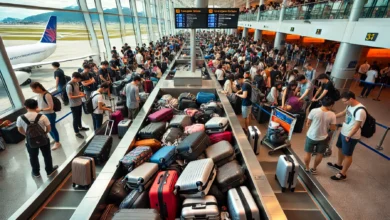What Adapter Do I Need for France & Paris?
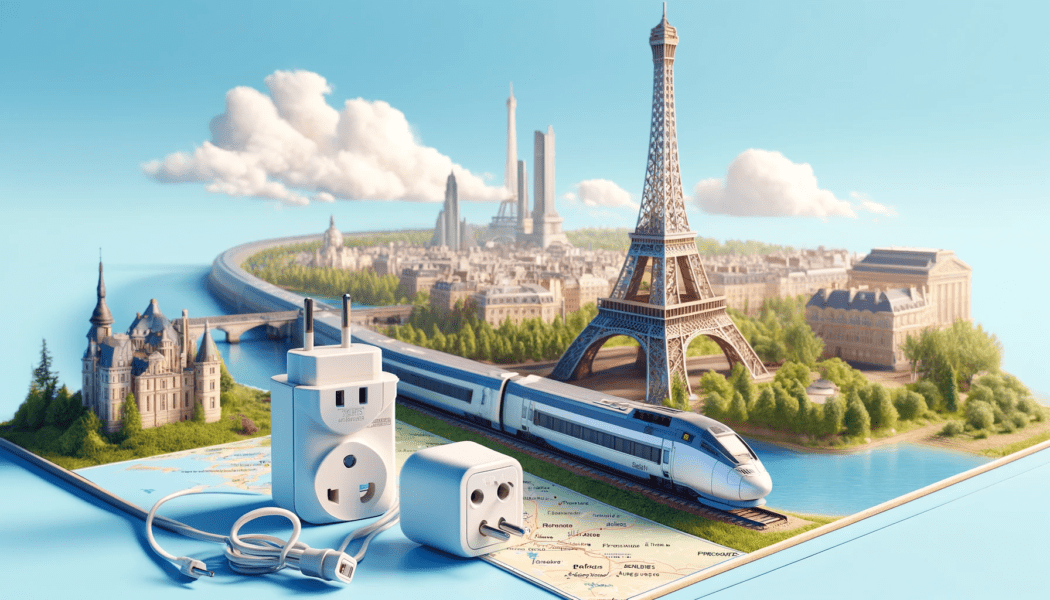
Your Guide to France & Paris Plug Adapters and Voltages
As a frequent traveler to France, I am often asked, “What adapter do I need for France?”
Understanding the plug adapters and voltage requirements is essential to ensuring a smooth trip.
Whether visiting the romantic city of Paris or exploring the beautiful French countryside, knowing which plug adapter you need for Paris is crucial.
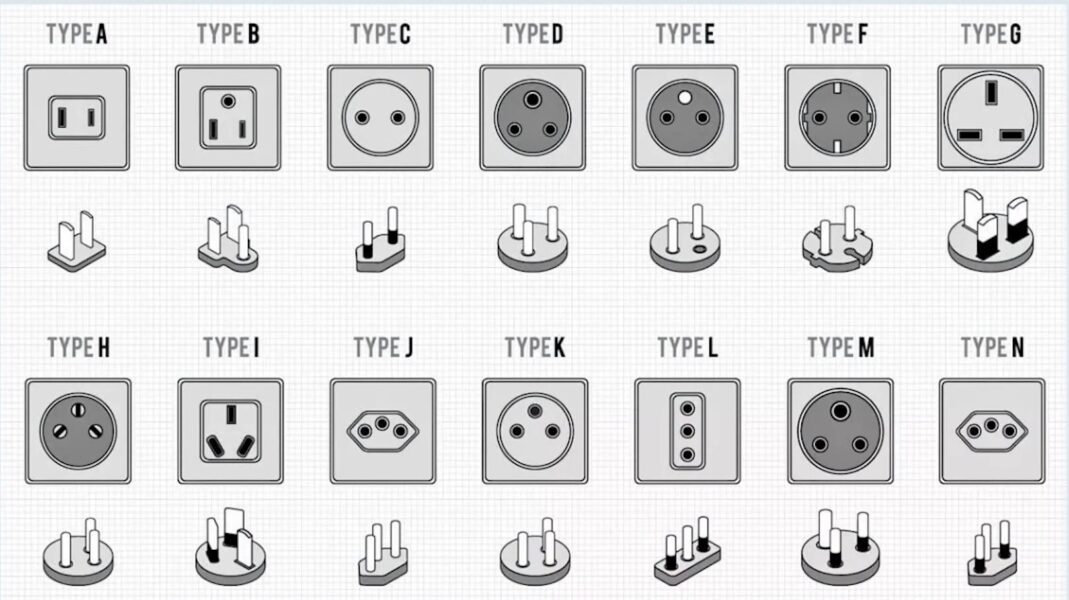
Understanding French Electrical Outlets
You’ll encounter Type C and Type E electrical outlets when traveling to France. Type C outlets take a plug with two round pins and no grounding pin, while Type E outlets take two round pins and have a grounding pin mounted in the outlet (see diagram).
Knowing the Paris outlet plug and Paris plug type is important to ensure your devices can connect properly. The standard voltage in France is 230V with a frequency of 50Hz. This information is vital for preparing your electronic devices.
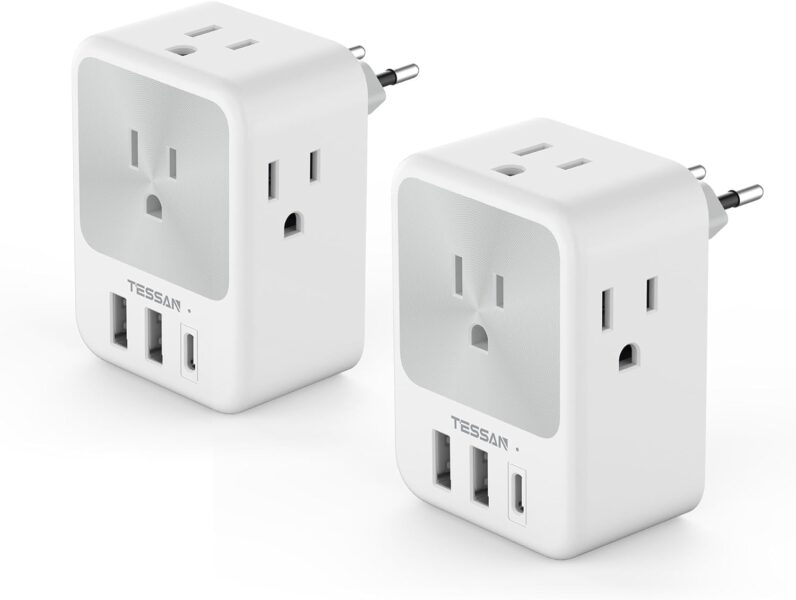
What Adapter Do I Need for France & Paris?
Plug Adapter Types for Paris & France
So, what plug adapter do I need for Paris?
For travelers from the US, a US-to-France plug adapter is necessary. You will need a Type C or Type E adapter to fit the outlets used in Paris.
Type C has two pins and is commonly used in older installations and regional areas of France.
The newer Type E also has two pins and a round socket for an outlet-mounted grounding pin and is becoming more widely used.
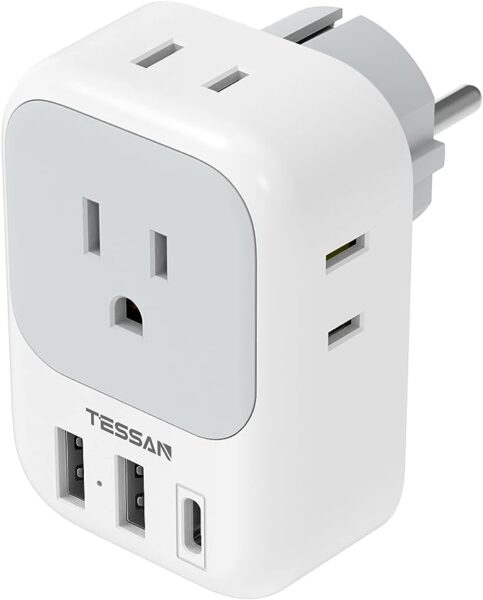
What Adapter Do I Need for France & Paris?
In my experience, Type C and Type E are generally interchangeable. However, to be safe, we travel with 3 Type E adapters and one or two Type C adapters (family of 4).
What makes these particular adapters good to use is their multiple USB outlets, perfect for charging equipment like computers and cell phones. They include USB-C and USB-A ports, the two most popular USB sockets. These versatile adapters are my favorite brand to use when traveling.
The Paris adapter allows your US devices to connect seamlessly to French outlets. To avoid issues, check your device’s compatibility with these plug types.
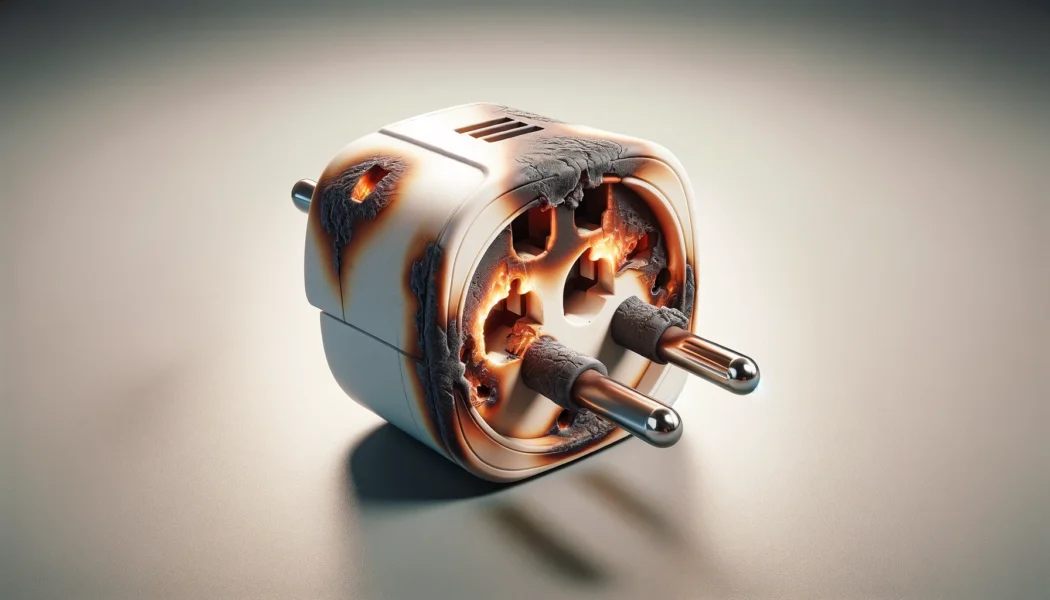
Cheap Plug Adaptors are Dangerous
Over the last 30 years, I’ve traveled multiple times to France and other European countries. Like everyone, I started trying to save money, including buying cheap plug adapters. Over the years, I’ve had two serious issues with cheap adapters.
Once, a cheap replica adapter caused arcing and almost started a fire at an Airbnb. Another time, at a hotel, a cheap adapter burned from the inside out, filling the room with an electrical and plastic-burning smell.
You can save on flights and accommodation but don’t skimp on adapters. The ones I recommend are slightly more expensive, but they ensure safety and peace of mind by preventing potential fires that could harm you and your family.
Voltage Requirements in France
Another important consideration is the voltage. The Paris voltage is 220 – 240V, different from the 110 – 120V used in the US. This raises the question: Do I need a voltage converter for France?
If your devices are not dual voltage (110V-240V), you will need a voltage converter to avoid damaging them. Always check your device’s voltage rating before plugging it into a Paris power outlet.
Voltage Converters
The Bonazza brand International Plug Adapter Power Converter Adapter Combo is among the best value for money and is highly rated on Amazon.
Where to Buy a France Charger Adapter Voltage Converter
It is highly recommended that you buy a France charger adapter voltage converter before your trip. You can find and buy these adapters easily online. The right Paris power outlet adapter is vital for keeping your devices charged and ready to use.
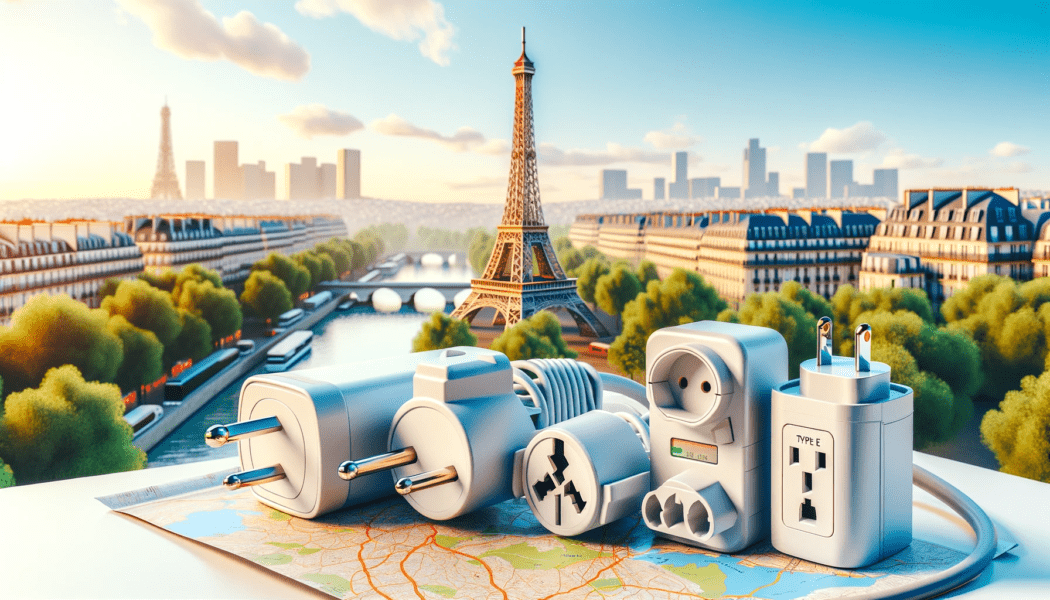
Practical Tips for Using Adapters in Paris
Using plug adapters in Paris is straightforward if you follow a few practical tips. Ensure your devices are compatible with the 230V standard in France. Double-check that your adapters and chargers fit securely into the Paris outlet plug. Carrying a multi-adapter or a power strip is also wise if you have multiple devices to charge.
If you’re unsure about your device’s voltage compatibility, look for the voltage rating on the device or its charger. Devices like smartphones, laptops, and cameras often support dual voltage, making them safe with just a plug adapter. However, appliances like hairdryers and electric shavers may need a voltage converter.
What Adapter Do I Need for France?
In summary, understanding what adapter you need for France is crucial for a smooth travel experience. Remember to pack a US to France plug adapter, specifically a Type C or Type E adapter, and check if you need a voltage converter for France.
With the right Paris adapter and knowledge of the Paris voltage and power outlets, you’ll be well-prepared for your trip.
This guide covers everything you need about plug adapters and voltage converters in Paris. Have safe travels, and enjoy your time in Paris!
4 Paris Tours Selected Just For You!
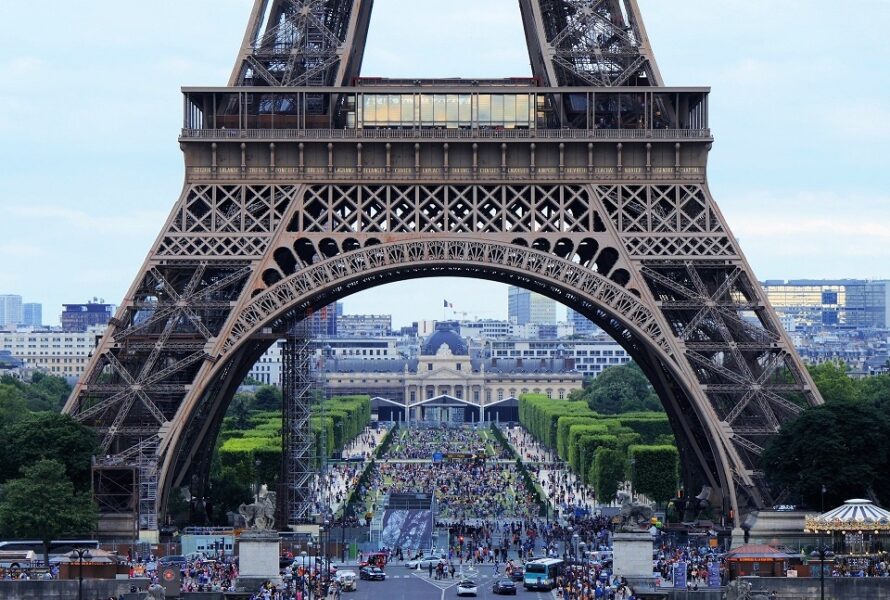
What Adapter Do I Need for France & Paris?
Guide to France & Paris: The Best Things to See & Do
If you want to eat gourmet food, explore the beautiful countryside, visit stunning Renaissance buildings, and see some of the most valuable art in the world, here is a France and Paris guide to help you plan a trip. Anyone interested in art and culture should visit France at some point.
France is Amazing
I can’t possibly tell you about all the amazing things to see and do in France in this brief guide, but I can guarantee you a taste of what you can expect from a visit to the French Republic.
Whatever your interests, I promise you’ll enjoy your stay in this historic nation.
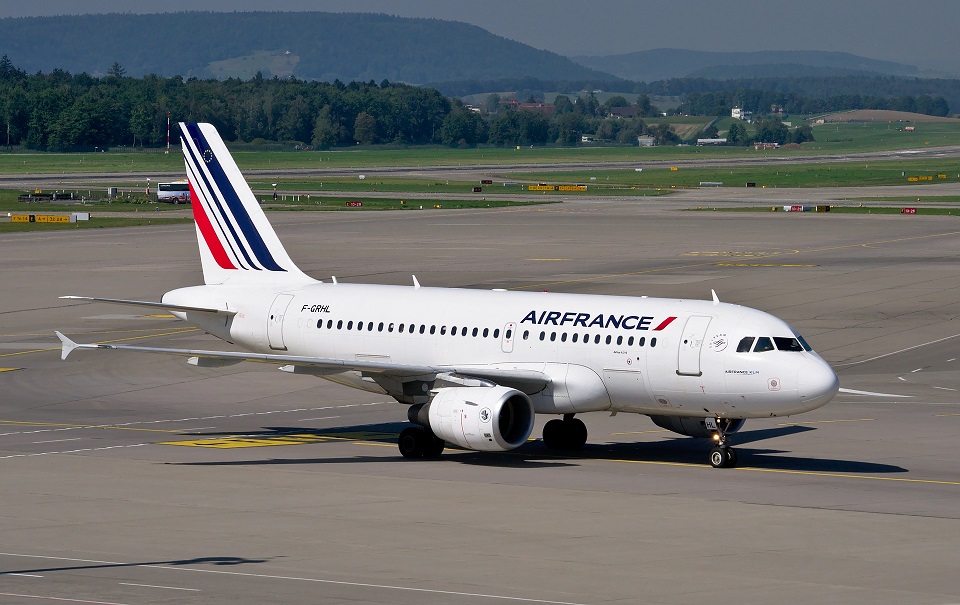
Airports & Entry
Because France is central to Europe, it is a major international transport hub. The three main international airports around Paris together form the world’s fifth busiest airport. France’s high-speed train systems provide rapid ground transport to any major European city.
If you choose to enter France from a neighboring European country, say the United Kingdom, the Netherlands, Belgium, Italy, Spain, Germany, and Switzerland, I’d recommend you take a high-speed train, such as the Eurostar, TGV, or Thalys, all operated by SNCF.
Railway Stations
Railway stations tend to be in city centers so, therefore, using a France map featuring these cities will help provide you with seamless transportation between places of interest.
For example, according to the SNCF website, you can take the Thalys train from Amsterdam to Paris in 3 hours and 20 minutes for €135 ($149). The SAS flight takes 4 hours and 10 minutes with one change and costs €145 ($160).
When sitting on the train, you can watch the French, Belgian, and Dutch countryside pass by so much better than from an airplane.
When the connections from the airport to cities are considered, rail transport is often more economical and can be as fast as air transport.
This is why, over the past decade, France has seen a decrease in air travel volume to neighboring countries. Passengers have swapped to new and improved high-speed trains to serve all the major cities in France.
Budget Airlines
You should research your journey before booking, as some budget airlines like Ryanair and EasyJet offer cut-price flights that are even cheaper than train tickets. You may find that on the particular day you wish to travel, you can save money by flying.
When I checked the Omio website, I discovered that a direct Transavia flight leaving next Thursday from Amsterdam to Paris Orly takes only 1 hour and 20 minutes and costs €92 ($101).
That is a significant saving on the current Thalys train price and so much faster, even considering transport from the airport into the city center of Paris.
If you are entering France from further afield, say, Africa, America, Asia, Australasia, Europe, or more than one country away, you are so much better off flying directly to one of France’s international airports.
You’ll probably get the most economical and direct flights to one of Paris’ three international airports: Paris-Charles de Gaulle, Paris-Orly, and Beauvais-Tillé.
Charles de Gaulle Paris
You will likely find budget flights to Charles de Gaulle Airport, the busiest airport in France and one of the busiest in the world.
However, there are some exceptions.
Today, Omio tells me I can buy a ticket from Newark Liberty International Airport in New Jersey to Paris-Orly for $364 to fly next Thursday. This is a 7-hour, 20-minute flight operated by Open Skies. The next cheapest flight is $405 from JFK to Paris-Charles de Gaulle, operated by Norwegian.
Both examples are much cheaper than the $1,000+ prices for most tickets from NYC to Paris. If you’re traveling on a budget, do your research, and you can save thousands on a family vacation to France by being flexible on departure and landing airports and choosing the best available tickets for your chosen date.
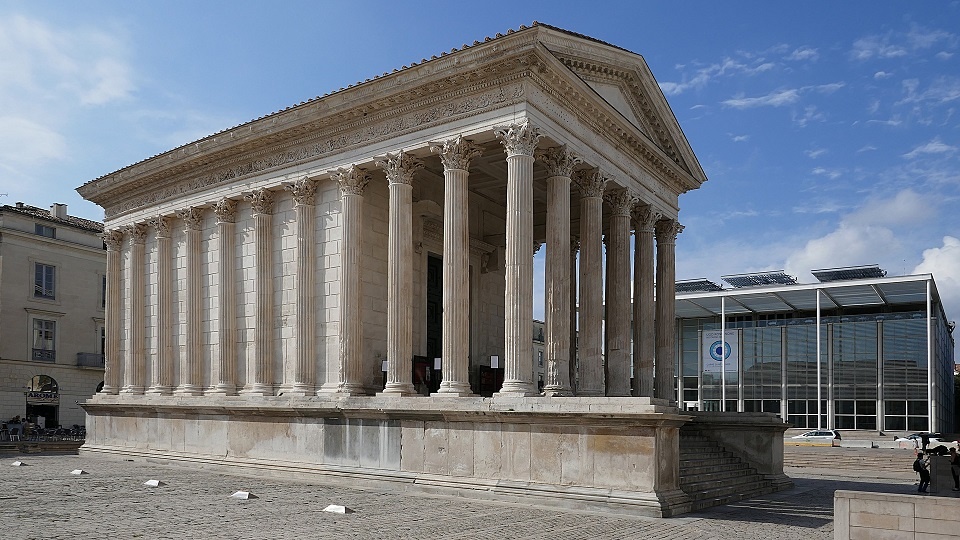
A Brief History of France
France has a long and complex history; as a result, I can only really scratch the surface. The earliest traces of human life date to 1.8 million BCE, and French paleontologists made many of the most important Neanderthal discoveries.
French researchers created much of the nomenclature to describe and record Stone Age tools.
Cave Art
The world’s most famous and beautiful cave art is in Lascaux Cave in Dordogne, southwestern France. Over 600 wall paintings of animals and cultural events from 17 thousand years ago are found in that complex.
The first of many Stone Age “Venus” figurines uncovered in Europe was found in the same area of France, rich in prehistoric archaeological sites.
Massalia, now called Marseille, was founded on the Mediterranean coast as a Greek colony in 600 BCE.
However, simultaneously, Celtic tribes migrating from central Europe became the dominant culture in the area and founded a territory roughly corresponding to modern France and known as Gaul.
Romans
When the Romans invaded and occupied southern Gaul in 125 BCE, they named it Provincia Nostra (Our Province), from which the modern region of Provence was derived.
By 52 BCE, the whole of Gaul was under Roman control and many Celtic cities were expanded and new cities founded, such as Calais, Lyon, and Le Mans.
The Celtic population embraced Roman culture and language, and modern French evolved from the dialect of Latin spoken in Gaul.
With the collapse of the classical Roman Empire in the 5th century CE, Roman Gaul was invaded by northern barbarians, including the Franks.
The Franks created a new empire, the Holy Roman Empire, which only lasted 43 years but controlled most of central Europe. When it split into three parts in 843 CE, the westernmost part was named West Francia, which was eventually shortened to France.
William The Conqueror
The growth of feudalism across Europe led to instability in France. When one of the vassals of the King of France became King of England in 1066 (William the Conqueror), three centuries of conflict began between England and France, with the King of England controlling vast areas on the French map.
With considerable help from God and Joan of Arc, King Henry VII was finally able to turn back the tide against the English in 1453 when he won the Hundred Years War. This victory ushered in the French Renaissance, when many fine buildings were constructed.
At its height under the Sun King Louis XIV, France became the most powerful nation in Europe and began building an empire that became the second largest in the world (just behind the British Empire). This included colonies in the Americas, Africa, and Asia.
Of course, the French Revolution following the Storming of the Bastille in 1789 caused a few dips in that progress, but Napoleon did his best to maintain France as Europe’s cultural and political heart.
Because of his efforts, most of the world uses the metric system, with meters, grams, and liters, to measure economic and scientific endeavors.
France Today
Today, the cities around France still boast the great monuments built during their age of empire, from the Sun King to the Belle Epoque.
France is also a treasure house of the arts, possessing many of the world’s most famous masterpieces, from the Bayeux Tapestry embroidered around 1070 and the Mona Lisa painted around 1506 to the great impressionist art of more modern painters like Renoir, Manet, Monet, and Degas.

A Fact File of France
- Official Name: The French Republic.
- Location: Western Europe.
- Population: 67 million.
- Ethnicity: 85% Celtic (the Gauls with Roman and Frankish blood), 10% Northwest African, 3% other black, and 2% Asian.
- Area: The France map takes in 247,368 square miles.
- Capital: Paris
- Seasonal Weather: Most of France has an oceanic climate with cool summers and mild winters with a small range in seasonal temperature. The far north and east areas experience a semi-continental climate with greater temperature extremes, i.e., hot summers and cold winters. The Mediterranean coast in the south has a Mediterranean climate with dry summers and wet winters. Technically, French Guiana in South America is a province of France, and the citizens enjoy tropical weather there.
- Official Language: French.
- Other Languages: Regional ethnic languages exist in various areas of France, including Alsatian (German), Basque, Breton, Catalan, Corsican, Flemish (Dutch), and Occitan.
- Religion: Officially, France is a secular country, but 51% identify as Christian (mainly Catholic), 40% atheist, 6% Muslim, 1% Jewish, and 2% other faiths.
- President: Emmanuel Macron.
- Prime Minister: Edouard Philippe.
- National Anthem: La Marseillaise.
- France news leaders (papers): Le Monde, Le Figaro, and Libération
- Time Zone: France adopts Daylight Saving Time in summer. The standard time zone is Coordinated Universal Time + 1, i.e., it is one hour before International Standard Time/the UK.
- Currency: The Euro.
- Country Dialing Code Prefix: +33
- Emergency Numbers: 112 for any emergency. For specific emergencies, you can dial 15 for medical assistance, 17 for the police, 18 for the fire brigade, and 114 if you are a disabled person with an emergency.
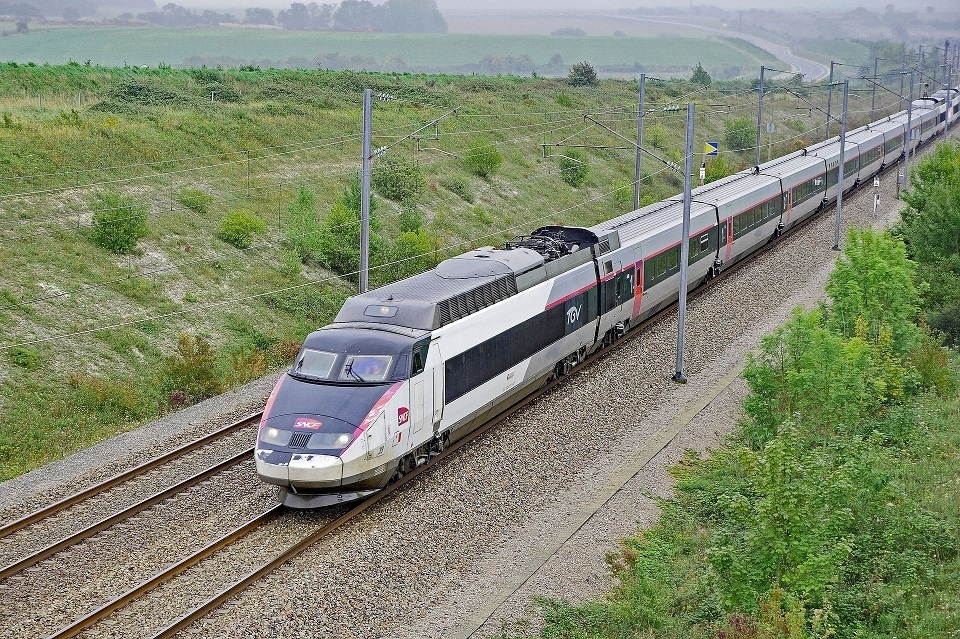
Getting Around France
With its extensive railway network, the best way to get around France is by train. However, it depends on what you want to see and how long you stay.
If you only want to visit a few cities that are far apart and you have limited time, sometimes you can pick up super cheap airfares from budget airlines like EasyJet, Norwegian, Ryanair, Transavia, and Vueling if you can book a month or more in advance.
Trains
SNCF operates high-speed trains and regular, slow services that allow you to coast through the countryside gently and enjoy France’s landscape.
You can download a Railways of France map here. You can also find more information on France’s National Rail Network (SNCF) here, including news, timetables, and bookings.
If you want to tour France on a budget, the best approach is to decide which cities or sights on the France map you want to see before you go and then buy your tickets well in advance.
A ticket from Paris to Strasbourg would cost me €107 ($118) if I want to travel today and €47 ($52) tomorrow. If I go one month from today, it will only cost €22 ($24).
The cost varies by day, but by juggling the days, you can work out your most cost-effective travel days and arrange your tour of France around more affordable transport.
Under 28-year-olds can get cheap prices on trains in France using a young person’s railcard.
A single-country Eurail Pass is a rail pass available to anyone outside of Europe. It provides a set number of train journeys within a month for a set price.
A EuRail Pass can work out much cheaper than paying for individual tickets. However, an extra charge will be applied to your journey if you opt to use a high-speed train with your Eurail Pass, and you must book in advance.
An adult Eurail Pass that allows seven days of unlimited travel within one month costs $419. An adult under 28 pays $315. An equivalent ticket for travelers from other European countries that costs the same is called an Interrail ticket.
Coaches
If you have lots of time but are traveling on a budget, you can use several national bus companies to tour France: Eurolines, Flixbus, Isilines, and Ouibus. Generally, you can travel cheaply by coach, but it will take much longer than by train.
However, be warned. You can often find cheaper train tickets than bus tickets if you book a month in advance and shop around. I recommend taking the train if possible because you’ll have a much more comfortable ride and get to places quicker. Plus, I’ve always found the view from trains more panoramic than inside a coach.
Hire a Vehicle
You can rent cars in France for a reasonable daily fee. For example, Budget will rent a small Renault Twingo for $38 a day in Paris. However, I have a couple of reservations.
Whether deserved or not, French drivers have a reputation for careless driving. The long, long freeways through France go on for long, long, monotonous miles with little change in scenery, which tends towards inattentive and sleepy drivers and potential accidents.
Similarly, while driving, it’s difficult to admire the scenery and easy to get lost even using a good map. Once you’ve added the gas to the rental charge, your journey will cost more than a budget train ticket if you travel alone or with only two people.
But, on the positive side, driving your vehicle allows you to go exactly where you want, when you want, during your vacation in France.
Car Sharing
An unusual option in France for budget travelers is ridesharing arranged online. Through BlaBlaCar, you can arrange to share a car with a French person traveling from one place to another. You’ll get to meet local people and learn about the culture. You’ll also pay much less than renting a car or taking a train.
If, for example, you share a car from Paris to Lyon, a verified driver who is a site member will take you for €24 ($26). The train costs around €45 ($50).
City Transit
Within French cities, you’ll find extensive public transport systems with trains, trams (streetcars or trolleys), and buses. They’re usually user-friendly and affordable. Taxis, however, can be expensive and are best avoided unless you’re in a hurry and have money to burn.
A French map of the Paris Metro, including all transit modes, may be found here.
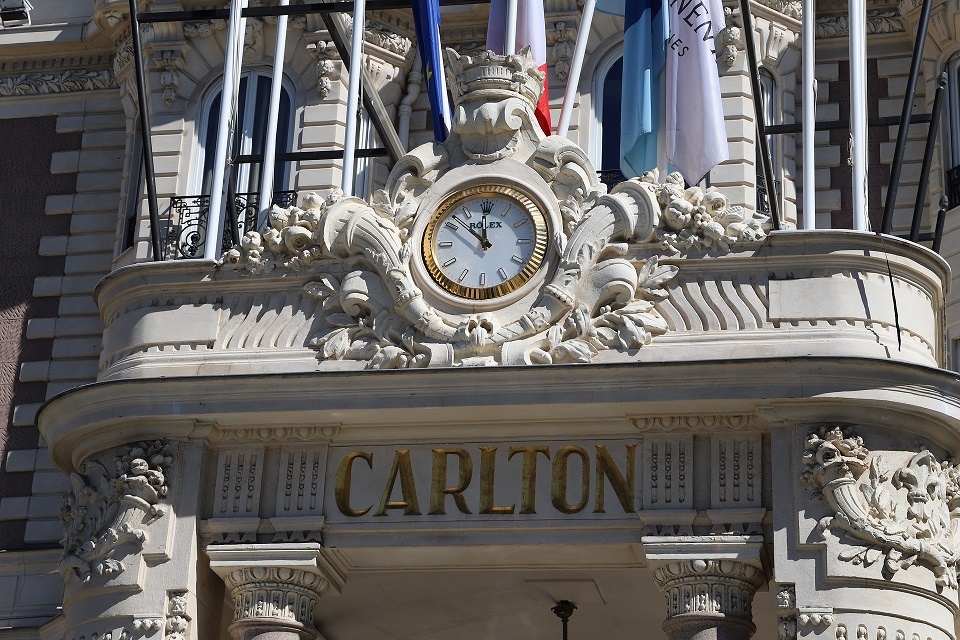
Accommodation in France
A wide variety of places to stay across France meet every requirement and pocket. The kind of accommodation you choose and where you stay depends entirely on your itinerary, tastes, and budget.
Luxury Hotel
France’s official Tourist Development Agency is so fussy about its top “palace” hotel rating that only 31 hotels nationwide have met the criteria. Around half of these are in Paris, including the ParkHyatt Vendome and the Shangri-La.
The others are spread out over the rest of the country, including Le Grand Hotel du Cap Ferrat in Nice and Le Cheval Blanc in Courchevel—an exclusive ski resort.
Any hotel that achieves this elusive “palace” rating will be incredibly plush, with a Michelin-starred chef and price tag to match. If you’re related to the Queen or have a billionaire sugar daddy, you’ll want to stay in one of these.
Boutique Hotels
Boutique hotels, which are small and often family-run and have only 15 to 50 rooms, offer a more informal atmosphere and affordable prices. They’re often found in unique, historic properties close to major attractions and tourist hotspots.
For example, take the Hotel Le Seize in central Nice. It is close to the Modern and Contemporary Art Museum, and the interior décor of this 34-room hotel celebrates street art and pop culture. The exterior is a historic structure from the Belle Epoque in the heart of the Old Town.
Or consider the Hotel St Claire in Toulouse. This intimate, 16-room hotel is half a mile from the city center and within easy walking distance of the Jeanne d’Arc Underground Station. It offers most amenities of a larger hotel but with friendlier staff and a cozier setting.
Hotel Chains
Many larger hotels around France are owned by multinational corporations, like Best Western, Ibis, Novotel, and Premiere Classe (Group de Louvre, 1-star budget hotels owned by Shanghai Jin Jiang International Hotels).
Most of these chain hotels are owned by Accor Hotels, the biggest hotel company in Europe. For example, it owns the Novotel Marne-la-Vallée Collégien Hotel near Disneyland Paris. Still, it doesn’t own the Best Western Premier Hotel Bayonne Etche Ona, which occupies two historic 17th-century houses in the center of Bordeaux.
Chambres d’hotes
Bed and Breakfasts are traditional accommodations in France. They enable you to interact with French people in an intimate environment and gain a deeper understanding of French culture and customs.
These are especially good choices for getting out into the countryside and enjoying an authentic French experience. Imagine staying with a French family in the Maison Jean Alain et Betty in a historic village in Provence or les Coccinelles (the three ladybugs) in the Champagne Region.
These quaint family homes are miles away from the sterile environment of multinational clone hotels, which could be anywhere from Chicago to New Delhi.
These are especially good choices for getting out into the countryside and enjoying an authentic French experience. Imagine staying with a French family in the Maison Jean Alain et Betty in a historic village in Provence or les Coccinelles (the three ladybugs) in the Champagne Region. These quaint family homes are miles away from the sterile environment of multinational clone hotels, which could be anywhere from Chicago to New Delhi.
Parisian Apartments
When staying in Paris, self-catering apartments are a popular option. However, they’re only cost-effective if you plan to stay for a week or more and come with a large family group or two families sharing one apartment. Otherwise, you can often find cheaper hotel accommodation for small numbers of guests and short periods of stay.
Gites
These are vacation rentals out in the countryside. Like Parisian apartments, these provide independence and freedom, but you won’t get the same interaction with French families that you would in a chamber d’hotes. These are great if you want a relaxing holiday in one rural location. But if you want to get out and explore the whole of France, they’re restrictive because they are usually booked for a whole week.
Gites and apartments can be booked through Booking.com or Chambres-Hotes.fr in their “Rentals” section.
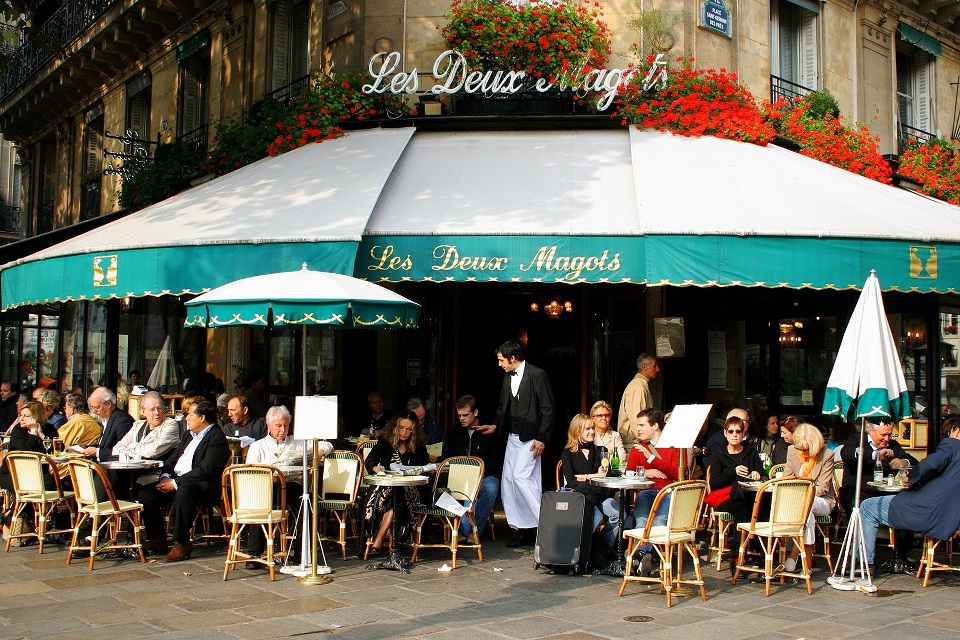
French Cuisine
Everyone knows that French cuisine has a reputation for being the best in the world. Most of the top chefs from around the world spent some time training in the culinary schools in Paris. But what is French food?
France absorbed the finest traditional food from all the countries surrounding it and then developed its unique style of preparing them, with copious use of its many famous wines and cheeses. There are many famous dishes from France, and here are a few of the most famous.
Breakfast
Around breakfast, you’ll see people walking out of small bakeries with long baguettes, just tucking into the light, freshly baked bread. French bread is amazing. But I particularly love to eat croissants, a popular buttery pastry, straight out of the oven. I add butter and strawberry jelly lashings, then eat them while drinking my morning coffee. Check out one of the many Parisian cafés, like Holly Belly Café.
Beef bourguignon is a beef stew cooked with red wine, mushrooms, pearl onions, fresh herbs, and garlic. Peasants originally developed this dish, and the slow simmering of the stew was intended to tenderize tough cuts of cheap meat.
Coq au vin reminds us of the importance of wine in French cooking. Typically, chicken is braised with a red Burgundy wine and cooked with bacon, mushrooms, onions, and garlic. La Jacobine has a great reputation for its coq au vin.
Vegetarians
Vegetarians will be thankful that not all dishes are meat-based. Ratatouille is probably France’s most famous vegetarian dish, originating in Provence. A selection of fresh vegetables—eggplant, zucchini, tomatoes, onions, garlic, carrots, bell peppers, and green herbs—are fried in a shallow frying pan on high heat and then transferred into a dish to be oven-baked.
For dessert, French gateaux are magnificent. And there are many other wonderful sweets, such as meringues, profiteroles, and chocolate souffle. If you’re in Paris, check out the amazing little bakeries on side streets that produce mouth-watering cakes that look as good as they taste. Check out the Pâtisserie Emma Duvéré or Dupain.
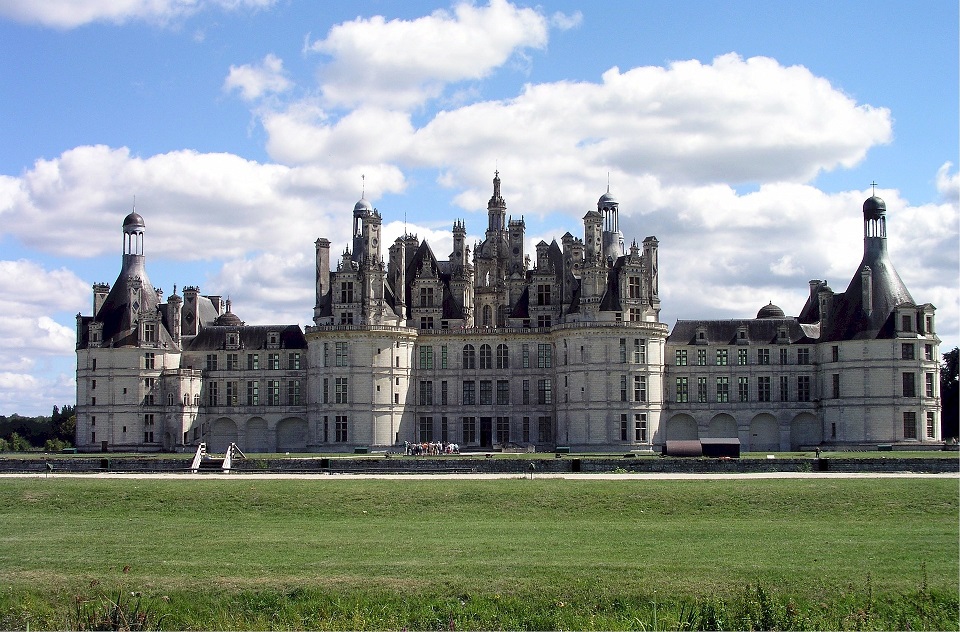
The Top 7 Places To Visit in France
France has many historic, cultural, artistic, and sporting attractions. Whether you want to hike through the beautiful countryside, explore ancient towns, play sports, or have fun, there’s something for everyone in the French Republic.
Disneyland Paris
The most visited attraction in France is Disneyland Paris, 20 miles east of central Paris. Today, it incorporates two theme parks: the original 1992 Disneyland Park and the Walt Disney Studios Park, which opened in 2002. Disneyland Paris is visited by 15 million people annually, making it the most popular theme park in Europe.
The parks are filled with Disney-related rides, like Big Thunder Mountain, and It’s a Small World, suitable for a wide range of children and youthful adults. You can also get up close and personal with Mickey and his friends or learn about the magic of animation and film production. The rides and attractions constantly evolve in response to new films and a changing audience.
Versailles
If you want to experience the grandeur of France at the peak of the Sun King’s reign, visit the Palace of Versailles, 12 miles southwest of central Paris. This Baroque masterpiece is one of the most luxurious palaces in Europe and a tangible reminder of Louis XIV’s absolute power. The one room that all visitors never forget is the Hall of Mirrors, where once loyal subjects awaited an audience with their king.
The formal gardens surrounding the palace feature ornate fountains and manicured shrubbery. The grounds highlight is Marie-Antoinette’s hamlet, a romanticized version of a French village. It was created so the queen could dress up and pretend to be a rural peasant in a perfect world.
The Alps
The French Alps are an excellent area for scenic hikes and winter sports. Scenic Mont Blanc is 15,774 feet high, the tallest mountain in Europe, and the site of the first Winter Olympics. Avoriaz and La Rosiere feature gentle pistes ideal for introductory skiing lessons and novice skiers. Skiing resorts like La Tania and Flaine were purpose-built as family skiing destinations. Val Thorens boasts great snow every year for serious and professional skiers.
Bordeaux
One of the things France is justifiably renowned for is wine production. Champagne is the first drink that comes to mind when celebrating a major event. And if you want a fine wine with your meal, look no further than Bordeaux. So, if you want to explore the French landscape, a great way to do this is touring vineyards.
The port city of Bordeaux on the southwest coast of France makes a great base for exploring romantic valleys with gothic chateaux and fields filled with neat rows of vines. There are thousands of wineries in the countryside surrounding Bordeaux that welcome you to tour their estates, observe their traditional wine-making processes, and sample some of the finest wines on Earth.
The Dordogne
A little east of Bordeaux is the Dordogne region. You can find many important prehistoric archaeological sites, like Lascaux Cave in the Vezere Valley. Although you can no longer enter the original cave due to preservation problems, an accurate reproduction of the cave’s interior is found inside Lascaux II.
Inside Lascaux II, you can see all the famous Lascaux paintings in vivid ochre hues, including the cows and horses in the Diverticule Axial and the bears and unicorns in the Hall of the Bulls. Visit the International
Center for Cave Art to experience an interactive 3-D show teaching you about prehistoric cave art and life in the Dordogne during the Paleolithic.
Normandy
Those interested in history often visit the coastline of Normandy near the ancient city of Bayeux. This is where the Allied forces landed to liberate France from German occupation during WWII.
Bayeux is a fascinating town because it houses the famous Bayeux Tapestry, which was made around 1070. The tapestry tells the story of the successful Norman invasion of England in 1066.
Bayeux was also the first town captured by Allied forces during Operation Overlord in June 1944, and consequently, General Charles de Gaulle made two of his famous speeches there.
From Bayeux, you can visit the D-Day landing beaches of Juno and Omaha beaches, the site of Pegasus Bridge, and the original bridge in the Pegasus Museum near Caen to the east.
One of France’s most famous medieval structures, the Abbey of Mont-Sant-Michel, is not too far away to the south, on an island off the coast spanning the border between Brittany and Normandy. Local legend claims that the Archangel Michael came down to Earth and ordered the building of a church on this rocky island. The abbey appears on the Bayeux Tapestry.
The Garden of France
Some of the most romantic buildings in France are located in the Loire Valley in central France. Stunning Renaissance chateaux are scattered throughout the beautiful river valleys and woodlands.
The Chateau de Chambord is an especially sumptuous fairytale castle built for King Francis I between 1519 and 1547. This large, ornate late-medieval structure makes the Disney Castle resemble a shantytown shed. It’s a must-see attraction for any history or architecture buff.
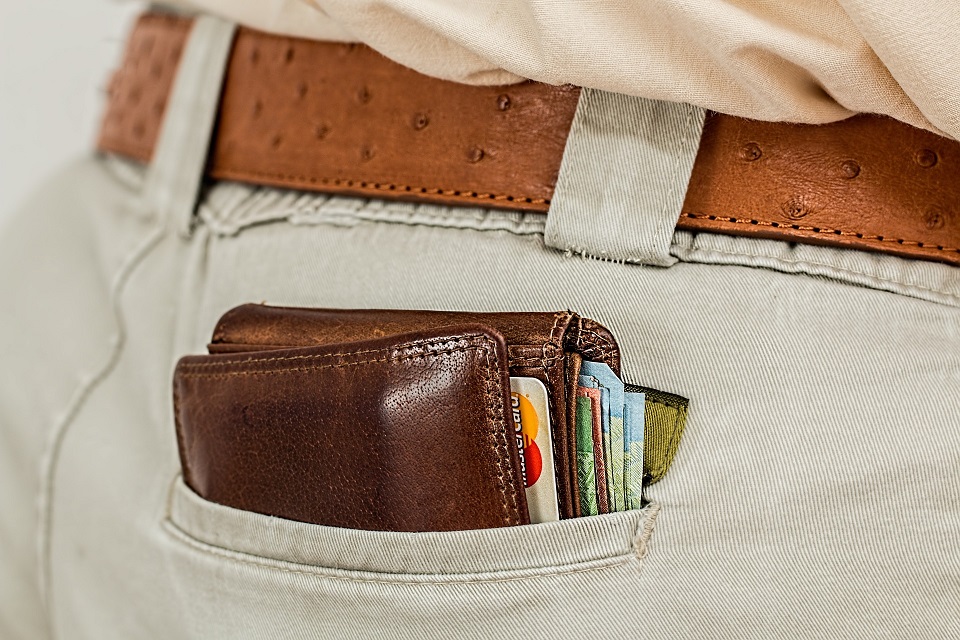
Visiting France Safely
Because France is relatively wealthy and stable, traveling here is considered safe.
However, things happen everywhere, and the November 2015 Paris Terrorist Attacks and the 2017 Tignes Avalanche serve to remind us that bad things can happen anywhere.
In the tourist hotspots and major cities, pickpockets and muggers do prey on naïve tourists as often reported by France News. In Paris, you should always be on the watch for purse snatchers, sometimes on motorbikes.
A common scam involves someone approaching you and acting helpful, such as offering local information. They are distracting you so their accomplice can whisk away your luggage.
France is Safe – But Be Careful
Don’t wear flashy jewelry in crowded places, keep your money inside a money belt or front pocket of your jeans, and avoid making eye contact with strangers. Be especially careful when using a credit card. Hide your hand while entering your PIN. Keep your luggage as close as possible on trains, physically attached to you or an immovable object.
When staying in a hotel, store your passport and any other valuables inside a room safe. Carry photocopies of your travel documents so that if you lose your passport and tickets, you can prove your identity and more easily acquire replacements.
Inside hotel rooms, make use of the door bolt at night. When leaving the room during the day, secure all the windows. Don’t forget how Kim Kardashian was robbed inside a luxury Paris hotel room in 2016!
Be observant when crossing the road. French drivers are known for aggressive driving, and pedestrians often do not have the right of way. If cycling, wear a helmet even though it isn’t mandatory. If you witness or are involved in an accident, do not hesitate to call 112 and ask for help.

What I love about Paris & France
France is such an amazing place to soak up culture. There’s a refined atmosphere on Parisian streets, inside the many art museums, and outside the cafés where Bohemian folks hang out. Generally, people seem to dress in more fashionable clothes and act civilized ways…except when driving.
I have learned that you get so much more welcome if you attempt one or two words of French…even just a bonjour, s’il vous plait, and merci.
Although I speak only about ten words of the language, I recall saying hello to a farmer standing in a field in the Champagne Valley. This led to a personal tour of his wine cellar and purchasing five dusty bottles of Champagne for just €10 each! Be friendly to the French, and they’ll reciprocate disproportionately.
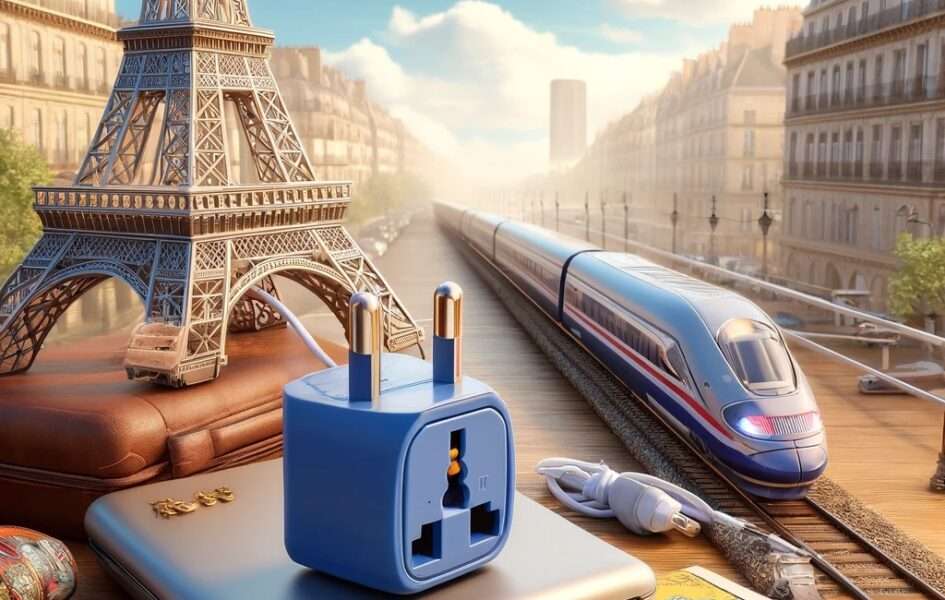
A Recap – What Adapter Do I Need for France?
Understanding the plug adapters and voltage requirements is essential when traveling to France. So, what adapter do I need for France? France uses Type C and Type E outlets, with a standard voltage of 230V.
If you’re coming from the US, you’ll need a US to France plug adapter. Specifically, you’ll require a Type C or Type E Paris adapter to connect your devices.
What plug adapter do I need for Paris?
To answer the question, “What plug adapter do I need for Paris?” you need a Type C or Type E adapter, which are the same as those for France.
These adapters fit the Paris outlet plug, allowing you to use your US devices.
The Paris and France, plug type C, has two round pins and Type E also has round pins and includes an additional grounding socket.
Paris Voltage
Another key consideration is the voltage. The Paris voltage is 230V, while the US uses 120V.
Do I need a voltage converter for France? If your devices are not dual voltage (110V-240V), you will need a voltage converter to avoid damaging them.
It is highly recommended that you buy a France charger adapter voltage converter before your trip. These adapters can be found easily online.
The right Paris power outlet adapter is vital for keeping your devices charged and ready to use.
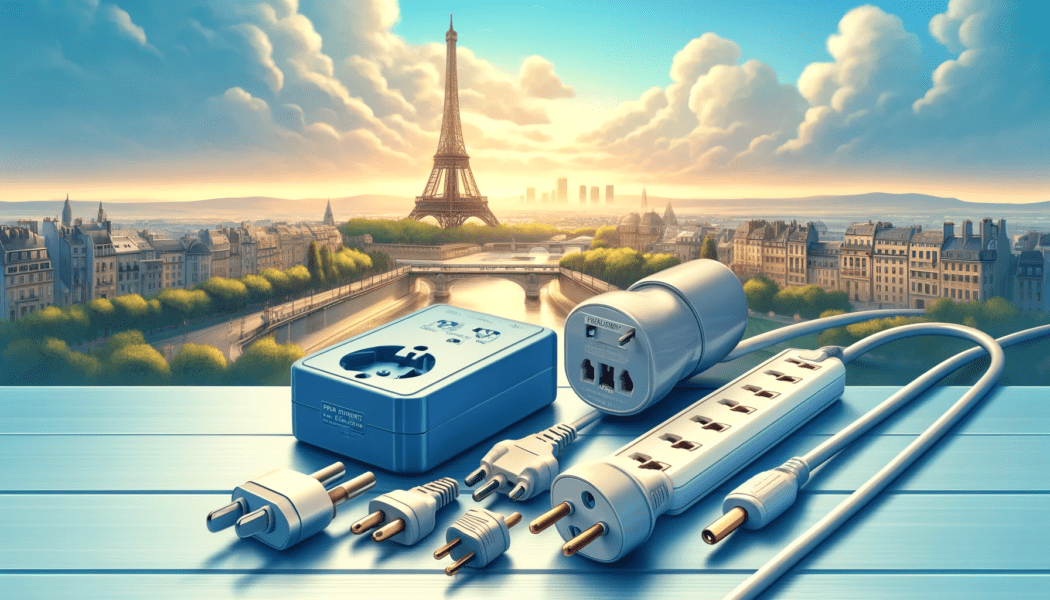
Plug Adapters in Paris
Using plug adapters in Paris is straightforward if you follow a few practical tips. Ensure your devices are compatible with the 230V standard in France.
Double-check that your adapters and chargers fit securely into the Paris outlet plug. If you have multiple devices to charge, carrying a multi-adapter or a power strip is also wise.
If you’re unsure about your device’s voltage compatibility, look for the voltage rating on the device or its charger.
Devices like smartphones, laptops, and cameras often support dual voltage, making them safe with just a plug adapter. However, appliances like hairdryers and electric shavers may need a voltage converter.
Parisien Vacation – What Adapter Do I Need for France & Paris?
Traveling to France and Paris offers many cultural, historical, and culinary experiences. Understanding the practical aspects, such as what adapter you need for France, ensures a smooth trip.
Remember to bring a US to France plug adapter, specifically a Type C or Type E Paris adapter, and check if you need a voltage converter for France to keep your devices running.
With the right preparations, you can enjoy France’s amazing sights and activities. Safe travels, and enjoy your adventure in this beautiful country!
Robert’s passion for nature and history began early when he preferred museums over beaches. An archaeology and anthropology graduate from Cambridge, he volunteered across the UK and explored China. Now, he writes about his adventures while his kids drag him to beaches and theme parks.

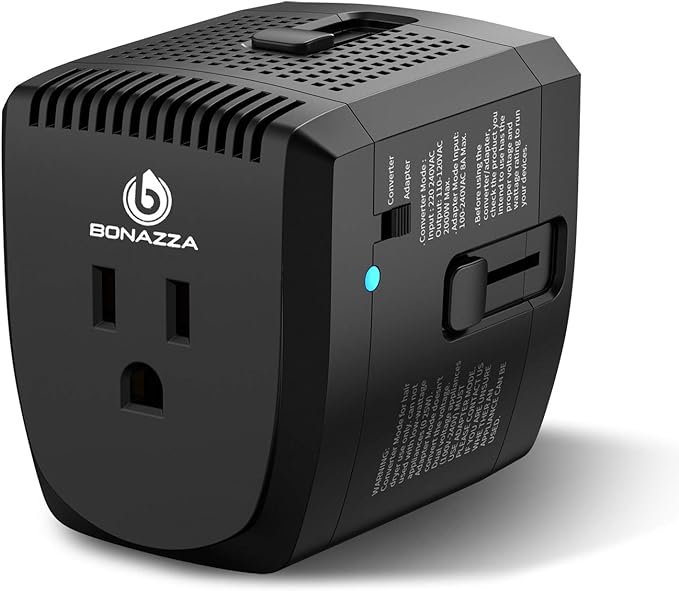
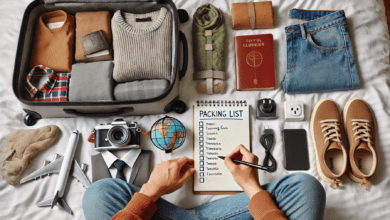
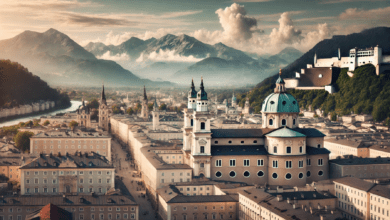
![How to Use Apple AirTags as Luggage Tracking Tags - [year] Update](https://theflightguy.com/wp-content/uploads/2024/06/image-140-390x220.png)

